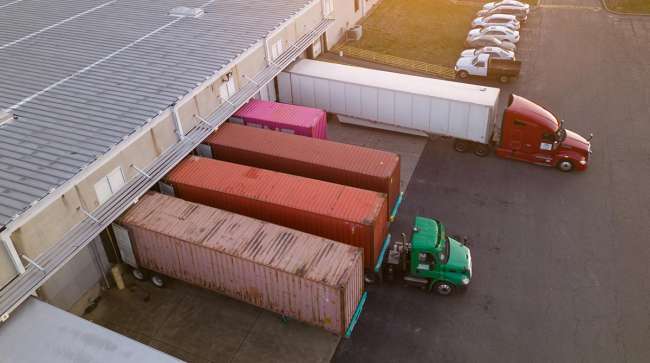Staff Reporter
Trucking Industry Reports Predictably Weak Q2

[Stay on top of transportation news: Get TTNews in your inbox.]
The trucking industry reported a weak second quarter with freight volumes and destocking efforts putting downward pressure on demand.
“I would say from a quarter perspective, it was bad,” said Wells Fargo analyst Allison Poliniak-Cusic. “But I don’t think that was unexpected. If I look relative to prior outlooks, volumes fell a bit deeper and pricing is a bit worse and I think that some of the companies expected to keep some of the gains that they made during the pandemic. And clearly consumer inventory builds, everything kind of combined, continues to push those freight dynamics down.”
Poliniak-Cusic added there haven’t been many signs of an economic recovery. But she has heard conversation around stabilization and whether the industry will turn around next year. She noted that while conditions are still bad, they don’t seem to be getting much worse.
“There’s no way to get around it, things are weak,” said TD Cowen analyst Jason Seidl. “Probably a little bit weaker than we thought, but not by a lot. I think there’s a prevailing feeling that we’ve already hit the bottom. I guess the big question, which remains unanswered, is how quickly do we come off the bottom.”
This is not a freight- or volume-led recovery. This is really a supply-led recovery.
Allison Poliniak-Cusic
Image
Citi analyst Christian Wetherbee pointed out that the truckload side of the industry was hit hardest. He also noted that the outlook for the second half of the year was challenging for those carriers as well. But less-than-truckload has been looking more promising, as Yellow Corp.’s declaration of bankruptcy frees up capacity and business.
“LTL is a different story,” Wetherbee said. “The numbers were not necessarily great for the quarter themselves. They were probably fine. But the outlook for the back half was significantly better because of what’s going on with Yellow.”
Yellow ranks No.13 on the Transport Topics Top 100 list of the largest for-hire carriers in North America and No. 3 on the TT list of the largest less-than-truckload carriers. The expectation is its market share will shift toward competitors like Old Dominion Freight Line, ArcBest, XPO or Saia. Wetherbee has even heard from carriers that process has already started.

Yellow Corp. trucks and trailers at a YRC Freight facility July 28 in Richfield, Ohio. (Sue Ogrocki/Associated Press)
“Now there was already a degree of underlying improvement sequentially in their business, which was there in truckloads,” Wetherbee said. “So those trends were consistent where late April, maybe early May, seemed to mark the bottom and then we saw improvement.”
Stifel Capital Markets analyst Bruce Chan pointed out that destocking efforts have added additional downward pressure on volumes. The problem is many retailers and warehouses became oversupplied, leading them to work down their inventory levels.
“We’d expected a heavier destocking period in the second quarter, which, of course, would have been a headwind,” Chan said. “The setup was for a pretty soft freight environment and moving into what actually transpired, I think that results were even weaker than that. What we saw was a deeper destocking freight pullback than anticipated.”
Chan added that destocking was further complicated by seasonal freight trends. He noted that there are certain goods that are only going to move in the second quarter, so it becomes difficult to destock them until then.
“There are signs that some customers on the trucking side have gotten through their inventory corrections,” Seidl said. “That’s some, definitely not all. So, I think we’ll still be working through the rest of that in the back half of the year. But again, it’s a positive sign, but I wouldn’t say it’s an overwhelmingly positive sign.”
Seidl is anticipating a slow and long recovery that is likely to materialize early next year. But he also doesn’t foresee things getting much worse, especially rates, having little room to go down.
“When you look at where some of the rates were in the quarter and even early on, maybe 3Q, there’s nowhere for them to really fall,” Seidl said. “When you’re still getting some rates out there in the spot market that don’t even pay for a driver, let alone all the overhead, the answer isn’t more freight at those rates. The answer is better rates and ultimately, I think, you’re going to get that from the group. The question is just how quickly.”
Want more news? Listen to today's daily briefing above or go here for more info
Poliniak-Cusic noted that there has been a lot of debate among her team over when the turnaround will happen. A major problem is the uncertainty around end consumers. She has also gotten mixed signals from major retailers with some starting to restock inventories and others holding off.
“A lot of what you might have heard during earnings, too, is this is not a freight- or volume-led recovery,” Poliniak-Cusic said. “This is really a supply-led recovery. Meaning taking supply out of the market to match that capacity with demand. Which is probably some of that stabilization that we’re hearing talked about, that capacity starting to right-size.”



